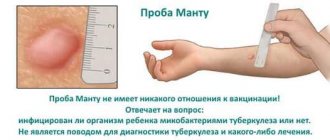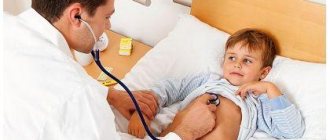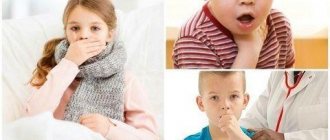Let's start with the fact that in all cases when a child has difficulty breathing, it is necessary to respond immediately and with the obligatory (!) involvement of medical workers.
The most common cause of difficulty breathing in children is VIRAL CROUP (false croup). What is it - croup? In many infections - both viral (ARVI, measles, rubella, chickenpox) and bacterial (diphtheria, scarlet fever) - the causative agent of the disease causes inflammation of the mucous membrane of the larynx and trachea. The lumen of the airways narrows and difficulty breathing occurs. This condition is called croup (inflammatory narrowing of the larynx and trachea due to infectious diseases). In more than 99.9% of all cases of croup, its cause is currently ARVI. But the very fact that in one child out of a thousand the cause of croup can be diphtheria or scarlet fever once again confirms the clear need to immediately involve a doctor to clarify the diagnosis.
The symptoms of croup are quite characteristic:
Before the doctor arrives, quickly let the baby breathe cool air (to the window, to the balcony). Warm drinks and warm clothes. Let me draw your attention once again: the most dangerous thing for a child with croup is warm and dry air[1].
Difficulty in exhalation occurs when there is spasm (contraction and, accordingly, narrowing) of the bronchi. The reason for this may be not only a viral infection, but also allergies (household chemicals, new furniture, cockroaches, painted floors, etc.). If there is difficulty in exhaling, but there are no other signs of infection (no fever, no red throat), the question of allergies is very relevant, and emergency help before the doctor arrives is to stop contact with the possible source of the allergy - again, outside, on the balcony.
Newborn breathing is of great importance as an indicator of health. The oxygen supply system is a vital function. Especially in children in the first days of life. The structure of the respiratory tract of babies is special: they are still short, so deep inhalations and exhalations are not yet possible. A narrow nasopharynx aggravates the process, so it is extremely important to ensure the most comfortable sleeping conditions. It would be useful to know why a newborn breathes often in his sleep, when is this normal, and what signs indicate abnormalities.
The baby's respiratory system in the first weeks after birth
A newborn baby develops very quickly. Human systems and organs grow at an accelerated rate. Therefore, pulse, respiration and blood pressure are always higher than those of an adult. In particular, the child's pulse can be up to 140 beats per minute. The baby's breathing is still shallow, frequent, and uneven. But this should not frighten parents if there are no additional signs of disease.
By the age of 6-7 years, life support systems return to normal, immunity increases, and all diseases are not so difficult to tolerate.
Nervous cough
The nature of nervous cough still remains not fully understood.
Some pediatricians believe that this is a habit that is difficult to overcome.
Nervous coughing is a psychological problem and appears in difficult life situations, that is, in an environment that can be called extreme. At night, when the child calms down and the spasm stops, this cough goes away on its own.
Nervous coughing is not a pathology, but a habit or symptom of another disease, so a medical examination may not show adequate results.
Children have an unformed nervous system and are easily susceptible to stress, which affects the entire body: stress causes spasm of the laryngeal muscles and coughing begins. By eliminating the cause of stress, you can overcome this type of cough.
Rapid breathing movements of a baby: normal or pathological
The frequency of inhalations and exhalations on the first day is very high, up to 60 movements. This is called transient hyperventilation and helps the baby adapt to life outside the womb.
So that mom and dad don’t worry about the frequency of movements of the child’s oxygen supply system, you should know about certain types of breathing. There are three of them in total. Let's look at each of them in detail:
- Breast. With such movements, the upper section actively works. In this case, the baby may suffer from poor ventilation of the lower lungs.
- Abdominal. This is evidenced by movements of the abdominal wall and diaphragm. And with prolonged breathing of this type, the upper parts of the lungs suffer.
- Mixed. The most optimal type, in which both the abdomen (diaphragm) and chest rise rhythmically.
If the little one does not have a stuffy nose, all systems work normally, he should inhale briefly 2-3 times, and then take one long breath. They are all superficial, but this is the norm. As the weeks pass, the breathing system is restored and becomes rhythmic and deep.
Complications
Children who become ill with ARVI are often treated at home. Parents do not consider it necessary to go to see a doctor and self-medicate. About statistics, complications arise in 20% of self-medication. Incorrect therapy, or therapy based on traditional medicine, leads to terrifying consequences. Otitis media, sinusitis and tonsillitis are the most common.
The first sign of the onset of complications is an increase in body temperature after it has stabilized. In the first 4-5 days from the onset of the disease, the immune system fights the cause of the disease and elevated temperature is the norm here. It is appropriate to talk about complications if the elevated body temperature returns or persists for more than five days in a row.
A runny nose persists for more than a week, the cough has intensified, pallor and sudden sweating have appeared, the child may be anxious or capricious, and the general condition has worsened. When observing similar symptoms, there is no time to discuss with friends or search for information on the Internet.
It is necessary to visit a doctor or call a doctor to your home for an examination and treatment. Every minute, hour and day matters. Complications can develop rapidly, multiplying their negative effects and consequences.
Measures to prevent influenza and ARVI are easy and will protect your child from frequent illnesses. After all, it is easier to prevent a problem than to solve it. Vaccination may not completely protect against the likelihood of getting sick, but it will prevent a severe course of the disease with complications.
Support immunity with a balanced diet and moderate physical activity. ARVI hygiene - washing hands before eating and postponing trips to crowded places during seasonal exacerbation. Keeping children's feet dry and warm. These are easy steps towards making your child feel good.
Breathing problems in premature babies
Babies born before 37 weeks of gestation are called premature. Due to the inferiority of all life support systems, such babies have various problems. The earlier the baby is born, the more attentive the mother should be.
Causes of respiratory disorders:
- Underdevelopment of the lungs. Organ disorders threaten incomplete opening of tissues, and the baby puts much more effort into breathing. For such children, it is necessary to constantly maintain an artificial ventilation system.
- Apnea. The main factor here is an insufficiently formed respiratory brain center. But if in an adult such limitation is compensated by taking deep breaths, then a child is not yet physically able to breathe deeply, so there is no compensation. This is the main reason why long-term apnea occurs, which also requires vigilant monitoring.
As the baby grows up, all problems are solved naturally, the baby begins to breathe calmly and evenly.
Conditions that help a child breathe normally during sleep
To ensure normal breathing and healthy sleep for the newborn, Dr. Komarovsky advises not to forget about the standard preparation rules:
- Choose the right underwear. Both underwear and bed. In the first days of life, the child breathes not only through the lungs, but also actively uses the skin for this purpose. Therefore, there should be no synthetics, lace, or other delights that do not allow air to pass through well. Only natural absorbent soft fabrics that are pleasant to the body will help you sleep soundly.
- Like an adult, a child will not sleep a wink in the stuffiness. Fresh air and normal humidity are the main indicators of comfort. The second parameter is considered optimal at values of 45-60%. This level helps to naturally moisturize the nasal passages and is a good defense against bacteria and viruses. You can open the windows several times during the night, especially if the baby's sleep is heavy, he often begins to groan. Ventilation during feeding is also normal.
- It is important to choose quality accessories for relaxation. Since the skeletal and muscular systems of a small body are not formed, you should discard soft feather beds and down pillows, which can also cause difficulty breathing for the child. A newborn should sleep on a hard mattress.
Peculiarities of baby's breathing
The abdominal type of breathing is typical for a baby, when the child inhales and exhales, his tummy actively moves. All people are born with abdominal breathing, but as they grow older they switch to chest breathing. Pauses in breathing are also common in babies: the baby may breathe quickly and then stop breathing for a maximum of ten seconds before normal breathing resumes. Parents who constantly monitor their child's breathing during sleep may worry about this, but this is absolutely normal. This breathing pattern is called periodic breathing.
Diagnostic methods
If a mother hears a child coughing during his sleep, she should take him to the pediatrician or call a doctor at home in case of elevated temperature. Before visiting the doctor, you need to monitor your baby and check whether he has a fever and whether his stool has changed since the attack began at night. If the child complains of pain of any location, sore throat or runny nose, the mother should report these symptoms to the doctor.
Such a cough is sufficient reason to give him a referral for a general blood and urine test. These tests must be taken as quickly as possible. The attending physician needs to know whether an inflammatory process is developing in the body or not. By analyzing sputum, you can determine which microorganisms became the causative agents of the disease, as well as determine their sensitivity to certain groups of medications.
When parents complain of a child’s coughing attacks at night, the doctor may refer the child for special diagnostic procedures. An X-ray examination of the lungs is carried out if severe diseases of the respiratory tract and lungs are suspected. Ultrasound of the lungs and bronchi is prescribed much less frequently than x-rays. However, if a cough after sleep is accompanied by difficulty breathing, the doctor may recommend such a study to exclude some rare diseases.
If necessary, the pediatrician refers the little patient to a consultation with a pulmonologist or allergist to determine the exact cause of the disease.
What are the signs of breathing problems in a child?
A deviation from your normal breathing pattern may indicate a health problem. There are signs parents should check to know if their child has breathing problems:
- Increased breathing rate of more than 60 breaths per minute. A baby may breathe quickly when excited or crying, but not when sleeping or at rest. If your baby is always breathing quickly, check for signs of illness, such as fever and colic.
- Irregular breathing with pauses. If a child pauses for more than ten seconds, it is cause for concern. If the pause is longer than 20 seconds, it may be a sign of apnea, which occurs due to narrowed airways.
- Flaring of the nostrils. If a child has trouble getting air into the airways, the nostrils will tense or flare with each breath.
- Mouth breathing. If a child prefers to breathe through the mouth, this may be an indicator of inflammation of the tonsils or adenoids due to infection. This condition can cause obstructive sleep apnea, which leads to breathing problems.
- Intense breathing with the participation of auxiliary muscles. If parents notice that the child is straining the chest inward during each breath to get enough air into the lungs, this is a sign of breathing problems.
- Constant cough and wheezing. Coughing and wheezing from time to time is not dangerous, but if it is constant, it indicates a problem. Coughing and wheezing may occur when a child is suffering from a cold because excess mucus accumulates in the respiratory tract, making breathing difficult.
Traditional methods for treating cough
Traditional medicine was invented because no other more effective means had yet been invented. Sometimes traditional medicine treatments work well, however, this is a small percentage of all grandma's health recipes.
Inhalation over boiled potatoes.
It is better not to use this type of treatment. There are more therapeutically significant components for inhalation, for example, inhalation with eucalyptus balm, soda solution.
Pharmacy inhalers are a priority: they are safer and help you heal faster. The home inhalation procedure itself is questionable, at least because the child may get burned.
Gargling with iodine, salt, kerosene.
Under no circumstances should you use this method. It is better to take pity on the already inflamed mucous membrane and not aggravate its condition. The salt solution can cause vomiting, increase pain in the throat and increase inflammation.
For example, iodine is not a drug that can be used widely and thoughtlessly. Iodine is quickly absorbed through the skin, which makes it easy to exceed its permissible value in the body, which can lead to problems with the thyroid gland. It’s simply scary to talk about kerosene: it is a solvent, fuel, poison, but not a medicine. It is contraindicated both locally and internally.
Mustard compresses.
In folk medicine, there are methods for treating coughs using mustard. Recipes for compresses applied to the chest and neck area are striking in the unusualness of the additional components. It is forbidden to do thermal procedures at a fever, as this will worsen the course of the disease.
Alcohol compresses.
Applying compresses with alcohol-containing products to the skin will easily cause alcohol intoxication. Contraindicated for infants.
Treatment using the grandmother's method is applicable when there are no other available methods. It happens that official medicine has nothing to offer, but this in no way applies to the treatment of cough with ARVI.
When you need a doctor: runny nose and other problems
It is important to show your baby to a specialist in situations where breathing is so fast that it is difficult to count. The baby can breathe at least 80 times per minute. This kind of breathing is medically called tachypnea. It is important to show the baby to the doctor if the child grunts with every breath, this indicates respiratory distress, severe runny nose and other problems.
A whistling sound (stridor) that can be heard when the child inhales requires evaluation by a doctor. Stiff breathing can be caused by congenital abnormalities in the respiratory system. It may also be an indicator of a condition called laryngomalacia, an abnormal development of the larynx that causes noisy breathing. This is a serious condition that may require surgery.
It is dangerous if, with a runny nose or cold, the skin color turns blue on the fingertips, cheeks and lips (cyanosis), which indicates a serious breathing problem. A child with cyanosis may have low oxygen levels in the blood and even have heart complications that require immediate medical attention. Timely diagnosis and treatment are necessary to eliminate any breathing problem, even if it is a common runny nose in a newborn.
How to determine if there is a problem
Parents are encouraged to listen to the baby's breathing rhythms during nighttime sleep. Note the appearance of symptoms such as:
- change in the nature and color of the skin (blue or pale skin, especially in the lips or eyes);
- presence of snoring;
- restlessness during sleep (the child cannot sleep peacefully, shudders, tosses and turns, whines);
- increased sweating (hyperhidrosis);
- breathing through the mouth (including while awake);
- enuresis, other disorders of the central nervous system;
- frequent attacks of shortness of breath.
If these symptoms occur, it is recommended to consult a doctor to determine the cause of the disorder and prescribe an effective treatment regimen.
Problems with breathing rhythm disturbances in infants are often observed. However, in most cases, the disorder is not associated with a specific disease and develops against the background of adaptation and formation of the child’s respiratory system. To identify the cause of the disorder, it is necessary to analyze the breathing rhythms of the newborn and pay attention to other symptoms. If you have any suspicions, it is recommended to consult a specialist.









